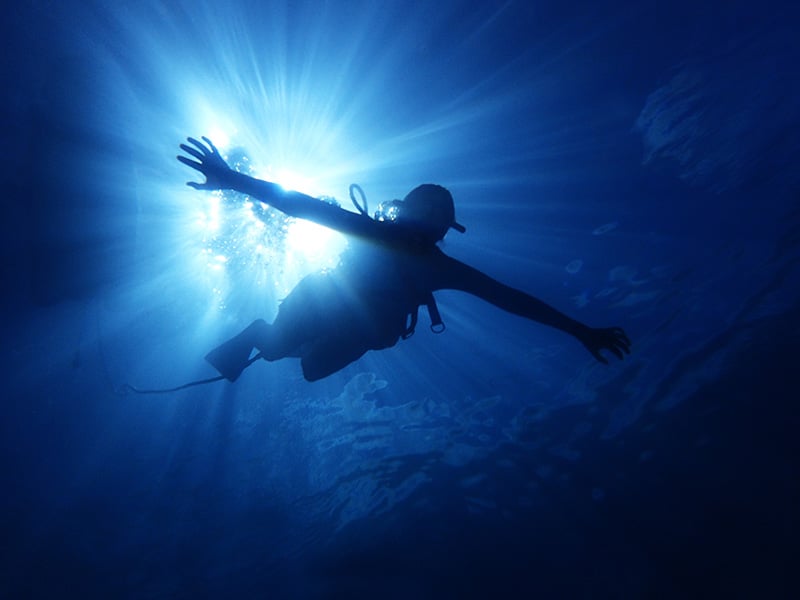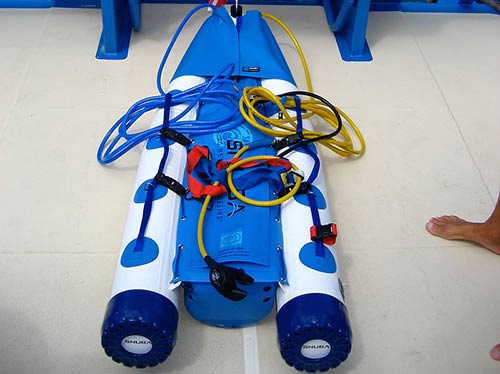Snuba, as the portmanteau implies, is a fusion of snorkeling and scuba diving. In snuba, a diver uses an air cylinder and a regulator to breathe under the water.
This makes snuba more closely related to scuba diving than to snorkeling, but it does have some commonalities with both forms of underwater exploration.
What is snuba diving?

Snuba diving is diving beneath the surface of a body of water while breathing through a regulator that is connected by hoses to an air supply which remains on the surface.
This air supply is in the form of compressed air cylinders that work just like a scuba diver’s dive tank, providing air through the hoses to the regulator which allows the diver to breathe normally.
Once underwater, the diver can dive down as far as the snuba equipment allows – 20 feet or 6 meters – and can move freely about.
Snuba Gear
When diving, a snuba diver wears many of the same pieces of equipment a scuba diver wears.
The main, and most important, two pieces of equipment are a diving mask, which connects to the diving regulator, allowing the diver to see and to breathe.
The air supply for snuba is housed in a specially-designed raft apparatus that moves over the water’s surface.
Other equipment worn for snuba includes fins, which helps a diver move beneath the water, and diving weights, which counteract natural buoyancy and keeps a diver neutral at any depth.
A snuba diver also wears a small, flexible harness that wraps over one shoulder and around the torso.
This harness is attached on its other end to the air cylinder raft.
The harness allows the diver to pull the raft with them as they swim or float beneath the water.
The snuba harness also limits the diver to the maximum length to which they can safely dive while breathing through a snuba hose and regulator (20 feet/6 meters).
Snuba vs Scuba Diving
As mentioned in the intro, snuba is more closely related to scuba diving than to snorkeling when it comes to actual breathing technique.
Both use a combination of compressed air tanks, hoses, and regulators to allow a diver to breathe almost normally beneath the surface of the water.
The two major differences between snuba and scuba diving are dive-depth and certification.
Snuba Dive-Depth
Snuba diving range is anywhere from just below the water’s surface to 20 feet/6 meters.
While scuba diving can be done at any depth, basic scuba diving certification starts divers at 30 feet/9 meters below the surface.
Scuba divers are also capable of doing “deep dives” of 60 feet (18 meters) or more, and the recreational depth limit for scuba is 130 feet (39 meters).
Obviously, a big difference in how far down you can go.
Snuba Certification
While you can go a lot deeper with scuba diving compared to snuba, those deep dives are more dangerous and require considerably more training to do safely.
That’s why scuba diving requires certification.
Snuba doesn’t.
Snuba is done through guided tours, though, with guides who are trained to thoroughly inspect equipment and brief divers on how to properly and safely use all equipment.
Snuba vs Snorkeling
While snuba is closer to scuba diving than to snorkeling when it comes to breathing apparatus and technique, it is closer to snorkeling when it comes to freedom of movement.
All in, scuba diving equipment weighs around 60 pounds, which means nothing when you’re under the water but can be quite cumbersome on a boat or dry land.
A dive tank is also bulky, requiring special consideration when diving to ensure it doesn’t get stuck or damaged.
The main differences between snuba and snorkeling are breathing style (as discussed above) and depth.
Most snorkeling is done on the surface, which allows the snorkel to access the air above the water.
While some snorkelers do dive to deeper depths, most snorkel manufacturers recommend a dive-depth of no more than 6 feet (2 meters) while wearing a snorkel to ensure you can return to the surface safely and clear the tube in time.
Is Snuba dangerous?
All forms of underwater diving come with some dangers, and snuba is no different.
The three main dangers with snuba are:
- Getting tangled
- Getting “dragged”
- Embolism
Getting Tangled in Snuba
When you snuba dive, you wear a harness that attaches you to the raft and breathe through air hoses connected on the surface.
Any of these “leashes” have the potential to get tangled in objects below.
It is possible to get your harness or air hoses tangled around coral or rocks while diving, or with your fellow snuba divers’ hoses or harnesses.
To stay safe, it’s essential to be aware of where your hoses and harness strap are at all times and of what’s around you.
Getting “Dragged” in Snuba
Dragging in snuba is more likely than getting tangled.
Since snuba rafts remain on the surface while you dive, they are subject to the currents of the water.
A strong wave or gust of wind can move the raft, and, since you are directly attached to it, you along with it.
This movement can pull quite hard on your body, potentially resulting in injury, and can also be disorienting, potentially resulting in panic.
The biggest threat of getting dragged by the raft in snuba is the potential for collision with underwater objects, such as rocks and coral.
Embolism
When you quickly ascend from below the surface of water, there is always the potential for embolism caused by over-inflation of the lungs.
This threat increases the closer you get to the surface, because most changes in air pressure take place within those last twenty feet and divers are more likely to hold their breath on ascension the closer they get to the surface.
To avoid embolism, you must keep breathing normally as you ascend.
This gives the lungs the chance to adjust.
Since snuba is done through guided tours, you will be briefed on these potentialities as part of your training. Just know, there is always some risk involved.
Snuba: Is it Worth It?
Since snuba is a midway activity between snorkeling and scuba diving, the question a lot of divers ask is “Is it worth it?” Is it better to just snorkel or scuba dive instead?
Obviously, the fact that scuba requires certification is an important factor here.
What snuba does offer over snorkeling and scuba diving is:
- Deeper dive-depths than snorkeling
- No need for certification like scuba
- Less bulky equipment than scuba
Since snuba is so closely related to scuba diving, and training includes many of the same fundamentals as Basic Scuba training, some people also use snuba as a testing activity to determine whether they want to learn to scuba dive.
This can be a beneficial experiment.
Snuba isn’t just a transitional activity to scuba diving, though. In the right place, with the right underwater landscape, snuba can be worthwhile in its own right, taking you further below the surface than snorkeling and requiring less time and financial expenditure than getting scuba certified.
top image license: Adobe Stock

